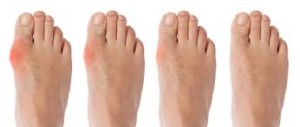During the flareup the joint will be red, swollen and very tender. Touching or moving the toe in any way will be intensely painful. In fact, individuals who are suffering from a flareup report that pressure as little as the bedsheet over the toe will increase the pain. (2)
Symptoms will generally develop in only one joint at a time. On rare occasions they will develop in two or three joints simultaneously, but if there are widespread symptoms then the condition is probably not related to gout.

The symptoms of this condition can be split into four different stages. In the asymptomatic stage the uric acid levels are rising in the blood but the individual experiences no symptoms. It is during the acute stage of the attack that individuals experience the pain, swelling and tenderness common with gout.
The intercritical stage is the time between episodes which are symptom-free. The majority of individuals will have a second attack from six months to two years after the primary attack. Some will live symptom-free for up to 10 years but most will have a second attack.
During the chronic stage individuals will suffer with persistently painful joints that have a large deposit of urate crystals in the cartilage, membranes and tendons and soft tissue around the joints. The skin over these deposits will develop sores and often release a white pus. The joint will become stiff and the individual will only have limited motion on this affected joint.
With early diagnosis and treatment and long-term dietary changes in lifestyle choices, many individuals will never reach the chronic stage. The changes which are required to ensure that the chronic stage is never reached are minor compared to the poor pain control and limited motion an individual will suffer if they reach the chronic stage of gout symptoms.
| Advertisement | |
 |
|



Leave a Reply